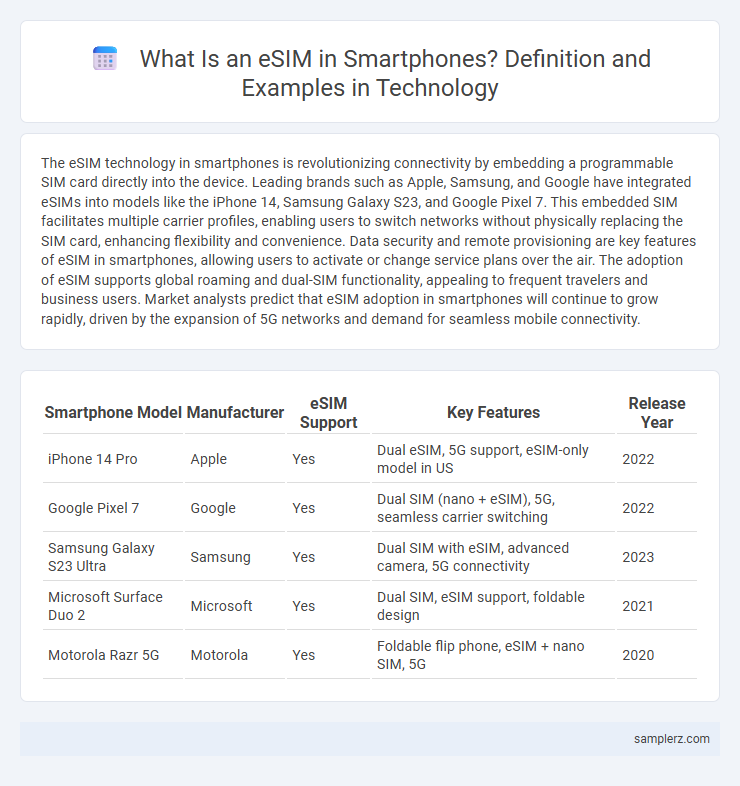The eSIM technology in smartphones is revolutionizing connectivity by embedding a programmable SIM card directly into the device. Leading brands such as Apple, Samsung, and Google have integrated eSIMs into models like the iPhone 14, Samsung Galaxy S23, and Google Pixel 7. This embedded SIM facilitates multiple carrier profiles, enabling users to switch networks without physically replacing the SIM card, enhancing flexibility and convenience. Data security and remote provisioning are key features of eSIM in smartphones, allowing users to activate or change service plans over the air. The adoption of eSIM supports global roaming and dual-SIM functionality, appealing to frequent travelers and business users. Market analysts predict that eSIM adoption in smartphones will continue to grow rapidly, driven by the expansion of 5G networks and demand for seamless mobile connectivity.
Table of Comparison
| Smartphone Model | Manufacturer | eSIM Support | Key Features | Release Year |
|---|---|---|---|---|
| iPhone 14 Pro | Apple | Yes | Dual eSIM, 5G support, eSIM-only model in US | 2022 |
| Google Pixel 7 | Yes | Dual SIM (nano + eSIM), 5G, seamless carrier switching | 2022 | |
| Samsung Galaxy S23 Ultra | Samsung | Yes | Dual SIM with eSIM, advanced camera, 5G connectivity | 2023 |
| Microsoft Surface Duo 2 | Microsoft | Yes | Dual SIM, eSIM support, foldable design | 2021 |
| Motorola Razr 5G | Motorola | Yes | Foldable flip phone, eSIM + nano SIM, 5G | 2020 |
Introduction to eSIM Technology in Smartphones
eSIM technology in smartphones enables the integration of a digital SIM card directly into the device's hardware, eliminating the need for physical SIM cards while allowing users to activate cellular plans remotely. Major smartphone brands like Apple, Samsung, and Google have incorporated eSIMs to support dual SIM functionality and improve network switching convenience. This embedded SIM technology enhances connectivity, simplifies carrier management, and supports global roaming capabilities without swapping physical SIM cards.
How eSIM Works in Modern Mobile Devices
eSIM technology in modern smartphones functions by embedding a programmable chip directly into the device, eliminating the need for a physical SIM card. This embedded SIM securely stores multiple carrier profiles, allowing users to switch networks remotely through software interfaces without changing hardware. The integration of eSIM enhances connectivity flexibility, supports dual-SIM capabilities, and simplifies global roaming by enabling instant carrier activation via over-the-air provisioning.
Top Smartphones Supporting eSIM in 2024
Top smartphones supporting eSIM in 2024 include the Apple iPhone 15 series, Samsung Galaxy S24 Ultra, and Google Pixel 8 Pro, all offering seamless dual SIM functionality without physical SIM cards. These devices enable instant carrier switching and enhance international travel convenience by supporting multiple profiles on a single embedded SIM. eSIM technology in these flagship models improves security and reduces hardware constraints, paving the way for future mobile connectivity innovations.
Advantages of Using eSIM in Smartphones
eSIM technology in smartphones offers seamless carrier switching without physical SIM card replacement, enabling greater convenience for users traveling internationally or managing multiple numbers. The embedded SIM reduces hardware space, allowing manufacturers to design slimmer, more durable devices with enhanced water and dust resistance. Enhanced security features prevent SIM swapping fraud while enabling remote provisioning and updates, optimizing user experience and operational efficiency.
Popular Carriers Offering eSIM Compatibility
Popular carriers such as Verizon, AT&T, T-Mobile, and Vodafone offer eSIM compatibility for smartphones, enabling seamless activation without physical SIM cards. Apple's iPhone 14, Google Pixel 7, and Samsung Galaxy S23 support eSIM technology, enhancing carrier flexibility and dual-SIM functionality. These major networks provide extensive eSIM plans, improving connectivity and simplifying user experience worldwide.
eSIM vs Physical SIM: Key Differences for Users
eSIM technology enables smartphones to activate cellular plans without a physical SIM card, offering enhanced convenience and seamless switching between carriers. Unlike physical SIMs, eSIMs are embedded directly into the device, reducing the risk of loss or damage and supporting multiple profiles for international travel and dual-SIM functionality. Users benefit from faster plan activation, improved security, and increased device durability due to the absence of a physical SIM slot.
Step-by-Step Guide: Activating eSIM on Your Smartphone
To activate eSIM on your smartphone, start by accessing the settings menu and selecting the cellular or mobile network option. Scan the QR code provided by your carrier or manually enter the activation details to add the eSIM profile to your device. Complete the process by confirming the activation and restarting your smartphone if necessary, enabling seamless connectivity without a physical SIM card.
Security Features of eSIM in Mobile Devices
eSIM technology in smartphones enhances security by embedding the SIM directly into the device, reducing the risk of physical SIM card theft or tampering. Advanced encryption protocols protect user data during activation and network authentication, ensuring secure communication channels. Remote provisioning and the ability to instantly switch carriers also minimize exposure to SIM card swapping attacks, strengthening overall mobile device security.
Real-Life Use Cases of eSIM in Smartphones
eSIM technology enables seamless switching between multiple mobile carriers without changing physical SIM cards, enhancing user convenience during international travel. Smartphones equipped with eSIMs support dual connectivity, allowing users to maintain separate personal and work numbers on a single device. This functionality improves network reliability by automatically selecting the strongest signal, which benefits professionals who require constant connectivity.
Future Trends: The Evolution of eSIM in Smartphones
eSIM technology in smartphones is set to redefine connectivity by enabling seamless carrier switching and improved device design without physical SIM slots. Industry leaders like Apple and Samsung are pioneering eSIM integration, supporting multi-profile management and global roaming capabilities. Future trends indicate widespread adoption of eSIMs will drive enhanced network flexibility, reduced manufacturing costs, and expanded IoT device connectivity.

example of eSIM in smartphone Infographic
 samplerz.com
samplerz.com